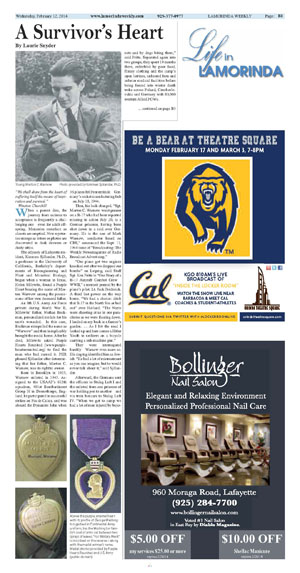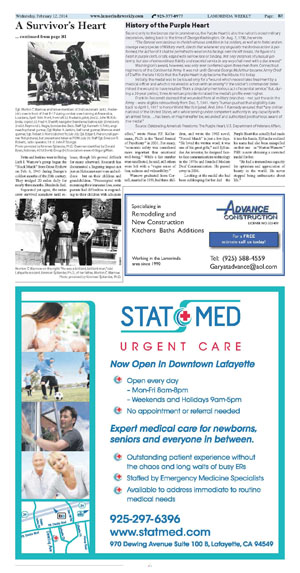| | Published February 12th, 2014
| A Survivor's Heart
| | By Laurie Snyder | 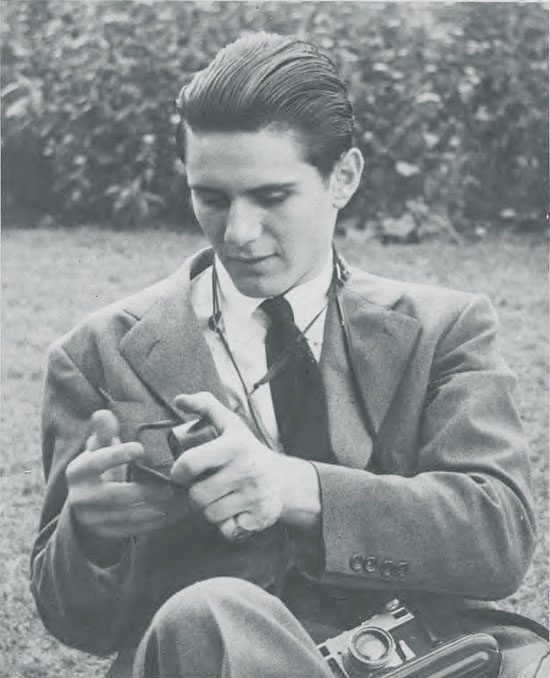 | | Young Morton C. Warnow Photo provided by Kimmen Sjölander, Ph.D. |
"We shall draw from the heart of suffering itself the means of inspiration and survival."
 - Winston Churchill
- Winston Churchill
 When a parent dies, the journey from sadness to acceptance is frequently a challenging one - even for adult offspring. Memories resurface as closets are emptied. New mysteries emerge as letters or photos are discovered in desk drawers or dusty attics.
When a parent dies, the journey from sadness to acceptance is frequently a challenging one - even for adult offspring. Memories resurface as closets are emptied. New mysteries emerge as letters or photos are discovered in desk drawers or dusty attics.
 The odyssey of Lafayette resident, Kimmen Sjölander, Ph.D., a professor in the University of California, Berkeley's departments of Bioengineering and Plant and Microbial Biology, began when a woman in Texas, Helen Milewits, found a Purple Heart bearing the name of Morton Warwow among the possessions of her own deceased father. The odyssey of Lafayette resident, Kimmen Sjölander, Ph.D., a professor in the University of California, Berkeley's departments of Bioengineering and Plant and Microbial Biology, began when a woman in Texas, Helen Milewits, found a Purple Heart bearing the name of Morton Warwow among the possessions of her own deceased father.
 An 8th U.S. Army Air Force private during World War II, Milewits' father, Nathan Beckman, personalized medals for his unit's wounded. In this case, Beckman misspelled the name as "Warwow" and then inexplicably brought the medal home. After he died, Milewits asked Purple Hearts Reunited (www.purpleheartsreunited.org) to find the man who had earned it. PHR phoned Sjölander after determining that her father, Morton C. Warnow, was its rightful owner. An 8th U.S. Army Air Force private during World War II, Milewits' father, Nathan Beckman, personalized medals for his unit's wounded. In this case, Beckman misspelled the name as "Warwow" and then inexplicably brought the medal home. After he died, Milewits asked Purple Hearts Reunited (www.purpleheartsreunited.org) to find the man who had earned it. PHR phoned Sjölander after determining that her father, Morton C. Warnow, was its rightful owner.
 Born in Brooklyn in 1925, Warnow enlisted in 1943. Assigned to the USAAF's 612th squadron, 401st Bombardment Group H in Deenethorpe, England, he participated in successful strikes on Pas de Calais, and was aboard the Dynamite John when 36 planes hit Peenemünde - Germany's rocket manufacturing hub - on July 18, 1944. Born in Brooklyn in 1925, Warnow enlisted in 1943. Assigned to the USAAF's 612th squadron, 401st Bombardment Group H in Deenethorpe, England, he participated in successful strikes on Pas de Calais, and was aboard the Dynamite John when 36 planes hit Peenemünde - Germany's rocket manufacturing hub - on July 18, 1944.
 Then, his luck changed. "Sgt. Morton C. Warnow, waist gunner on a B-17 who had been reported missing in action July 20, is a German prisoner, having been shot down in a raid over Germany. He is the son of Mark Warnow, conductor heard on CBS," announced the Sept. 11, 1944 issue of "Broadcasting: The Weekly Newsmagazine of Radio Broadcast Advertising."
Then, his luck changed. "Sgt. Morton C. Warnow, waist gunner on a B-17 who had been reported missing in action July 20, is a German prisoner, having been shot down in a raid over Germany. He is the son of Mark Warnow, conductor heard on CBS," announced the Sept. 11, 1944 issue of "Broadcasting: The Weekly Newsmagazine of Radio Broadcast Advertising."
 "Our plane got two engines knocked out after we dropped our bombs" on Leipzig, said Staff Sgt. Ken Fritts in "One Story of a B-17 Aircraft Combat Crew - WWII," a memoir penned by the plane's pilot, Lt. Jack Frederick. A third lost power on the way home. "We had a choice: ditch that B-17 in the North Sea or bail out" over Holland. "The Nazis were shooting at us in our parachutes as we were floating down. I landed on my back in a farmer's garden. ... As I hit the road I looked up and here comes a Hitler Youth in uniform on a bicycle carrying a sub-machine gun."
"Our plane got two engines knocked out after we dropped our bombs" on Leipzig, said Staff Sgt. Ken Fritts in "One Story of a B-17 Aircraft Combat Crew - WWII," a memoir penned by the plane's pilot, Lt. Jack Frederick. A third lost power on the way home. "We had a choice: ditch that B-17 in the North Sea or bail out" over Holland. "The Nazis were shooting at us in our parachutes as we were floating down. I landed on my back in a farmer's garden. ... As I hit the road I looked up and here comes a Hitler Youth in uniform on a bicycle carrying a sub-machine gun."
 They were interrogated harshly - Warnow even more so. His dog tag identified him as Jewish. "He had a lot of mistreatment as you can imagine, but he would never talk about it," said Sj?lander.
They were interrogated harshly - Warnow even more so. His dog tag identified him as Jewish. "He had a lot of mistreatment as you can imagine, but he would never talk about it," said Sj?lander.
 Afterward, the Germans sent the officers to Stalag Luft I and the enlisted from one prisoner of war holding pen to another - and via train boxcars to Stalag Luft IV. "When we got to camp we had a lot of men injured by bayonets and by dogs biting them," said Fritts. Separated again into two groups, they spent 19 months there, enfeebled by poor food, flimsy clothing and the camp's open latrines, unheated huts and inferior medical facilities before being forced into winter death treks across Poland, Czechoslovakia and Germany with 80,000 western Allied POWs.
Afterward, the Germans sent the officers to Stalag Luft I and the enlisted from one prisoner of war holding pen to another - and via train boxcars to Stalag Luft IV. "When we got to camp we had a lot of men injured by bayonets and by dogs biting them," said Fritts. Separated again into two groups, they spent 19 months there, enfeebled by poor food, flimsy clothing and the camp's open latrines, unheated huts and inferior medical facilities before being forced into winter death treks across Poland, Czechoslovakia and Germany with 80,000 western Allied POWs.
 Fritts and Jenkins went to Stalag Luft I. Warnow's group began the "Black March" from Gross Tychow on Feb. 6, 1945 during Europe's coldest months of the 20th century. They trudged 20 miles daily for nearly three months. Hundreds died.
Fritts and Jenkins went to Stalag Luft I. Warnow's group began the "Black March" from Gross Tychow on Feb. 6, 1945 during Europe's coldest months of the 20th century. They trudged 20 miles daily for nearly three months. Hundreds died.
 Separated yet again, the entire crew survived somehow until release, though life proved difficult for many afterward. Research has documented a lingering impact not just on Holocaust survivors and soldiers - but on their children and grandchildren. "Preoccupied with mourning their immense loss, some parents had difficulties in responding to their children with adequate affect," wrote Natan P.F. Kellermann, Ph.D. in the "Israel Journal of Psychiatry" in 2001. For many, "economic safety was considered more important than emotional well-being." While a fair number were unaffected, he said, still others were left with a "vague sense of fear, sadness and vulnerability."
Separated yet again, the entire crew survived somehow until release, though life proved difficult for many afterward. Research has documented a lingering impact not just on Holocaust survivors and soldiers - but on their children and grandchildren. "Preoccupied with mourning their immense loss, some parents had difficulties in responding to their children with adequate affect," wrote Natan P.F. Kellermann, Ph.D. in the "Israel Journal of Psychiatry" in 2001. For many, "economic safety was considered more important than emotional well-being." While a fair number were unaffected, he said, still others were left with a "vague sense of fear, sadness and vulnerability."
 Warnow graduated from Cornell, married in 1955, had three children, and wrote the 1962 novel, "Forced March" in just a few days. "He loved the written word; it was one of his great gifts," said Sjölander. An inventor, he designed face-to-face communications technology in the 1970s and founded Modern Deaf Communication. He passed away in 2006. Warnow graduated from Cornell, married in 1955, had three children, and wrote the 1962 novel, "Forced March" in just a few days. "He loved the written word; it was one of his great gifts," said Sjölander. An inventor, he designed face-to-face communications technology in the 1970s and founded Modern Deaf Communication. He passed away in 2006.
 Looking at the medal she had been safekeeping for her dad - the Purple Heart that actually had made it into his hands, Sjölander realized his name had also been misspelled on that one - as "Norton Warnow." PHR is now obtaining a corrected medal for her. Looking at the medal she had been safekeeping for her dad - the Purple Heart that actually had made it into his hands, Sjölander realized his name had also been misspelled on that one - as "Norton Warnow." PHR is now obtaining a corrected medal for her.
 "He had a tremendous capacity for optimism and appreciation of beauty in the world. He never stopped being enthusiastic about life."
"He had a tremendous capacity for optimism and appreciation of beauty in the world. He never stopped being enthusiastic about life."
 |
 History of the Purple Heart
History of the Purple Heart

 Second only to the bronze star in prominence, the Purple Heart is also the nation's oldest military decoration, dating back to the time of George Washington. On Aug. 7, 1782, he wrote:
Second only to the bronze star in prominence, the Purple Heart is also the nation's oldest military decoration, dating back to the time of George Washington. On Aug. 7, 1782, he wrote:
 "The General ever desirous to cherish virtuous ambition in his soldiers, as well as to foster and encourage every species of Military merit, directs that whenever any singularly meritorious action is performed, the author of it shall be permitted to wear on his facings over the left breast, the figure of a heart in purple cloth, or silk, edged with narrow lace or binding. Not only instances of unusual gallantry, but also of extraordinary fidelity and essential service in any way shall meet with a due reward."
"The General ever desirous to cherish virtuous ambition in his soldiers, as well as to foster and encourage every species of Military merit, directs that whenever any singularly meritorious action is performed, the author of it shall be permitted to wear on his facings over the left breast, the figure of a heart in purple cloth, or silk, edged with narrow lace or binding. Not only instances of unusual gallantry, but also of extraordinary fidelity and essential service in any way shall meet with a due reward."
 Washington's award, however, was only ever conferred upon three men from Connecticut regiments of the Continental Army. It was not until General George McArthur became Army Chief of Staff in the late 1920s that the Purple Heart truly became the tribute it is today.
Washington's award, however, was only ever conferred upon three men from Connecticut regiments of the Continental Army. It was not until General George McArthur became Army Chief of Staff in the late 1920s that the Purple Heart truly became the tribute it is today.
 Initially, the medal was to be issued only for a "wound which necessitates treatment by a medical officer and which is received in action with an enemy" if the soldier's commander determined the wound to have resulted "from a singularly meritorious act of essential service." But, during a 20-year period, three American presidents raised the medal's profile even higher. Initially, the medal was to be issued only for a "wound which necessitates treatment by a medical officer and which is received in action with an enemy" if the soldier's commander determined the wound to have resulted "from a singularly meritorious act of essential service." But, during a 20-year period, three American presidents raised the medal's profile even higher.
 Franklin Roosevelt decreed that wounded from all military branches - not just those in the Army - were eligible retroactively from Dec. 7, 1941. Harry Truman pushed that eligibility date back to April 5, 1917 to honor World War I's injured. And John F. Kennedy ensured that "'any civilian national of the United States, who while serving under competent authority in any capacity with an armed force..., has been, or may hereafter be, wounded' and authorized posthumous award of the medal."
Franklin Roosevelt decreed that wounded from all military branches - not just those in the Army - were eligible retroactively from Dec. 7, 1941. Harry Truman pushed that eligibility date back to April 5, 1917 to honor World War I's injured. And John F. Kennedy ensured that "'any civilian national of the United States, who while serving under competent authority in any capacity with an armed force..., has been, or may hereafter be, wounded' and authorized posthumous award of the medal."
 Source: Celebrating America's Freedoms: The Purple Heart, U.S. Department of Veterans Affairs.
Source: Celebrating America's Freedoms: The Purple Heart, U.S. Department of Veterans Affairs.
|
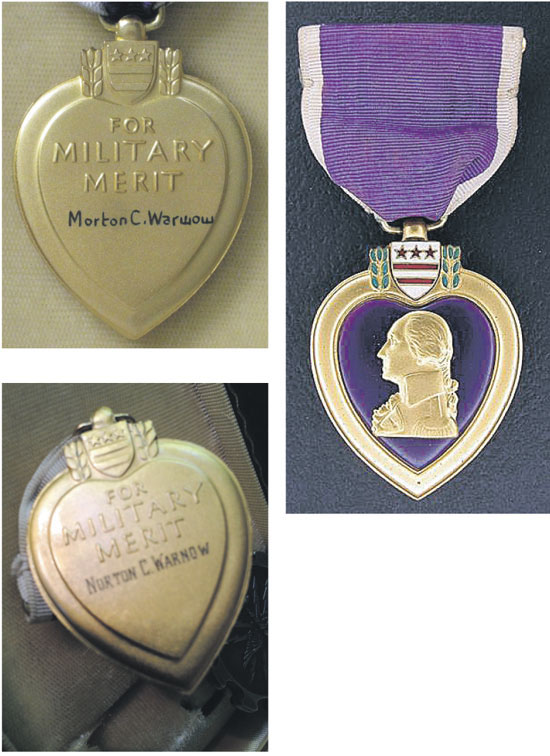 | | Above the purple, enamel heart with its profile of George Washington garbed in Continental Army uniform, lies the Washington family's coat of arms set between two sprays of leaves. "For Military Merit" is inscribed on the reverse - along with the medal winner's name. Medal photos provided by Purple Hearts Reunited and U.S. Army (public domain) | 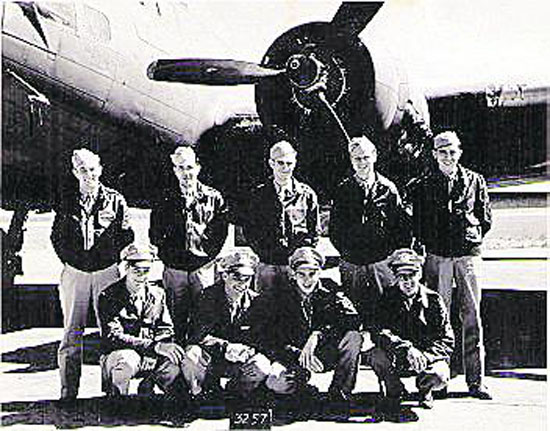 | | Sgt. Morton C. Warnow and fellow members of 2nd Lieutenant Jack L. Frederick's crew in front of their B-17 during combat crew training at Alexandria, Louisiana, April 1944. Front, from left: Lt. Frederick, pilot; 2nd Lt. John W. Kirkbride, copilot; Lt. Fred H. Sherriff, navigator (transferred before July 20 mission); 2nd Lt. Raymond L. Nagle, bombardier. Back: Staff Sgt. Kenneth H. Fritts, engineer/top turret gunner; Sgt. Walter H. Jenkins, ball turret gunner; Warnow, waist gunner; Sgt. Robert V. Norris (did not fly July 20); Cpl. Edgar E. Pierson, tail gunner. Not pictured, but present and taken as POWs July 20: Staff Sgt. Emerson R. Roberts, radio operator; 1st Lt. John P. Szungyi. Photo provided by Kimmen Sjölander, Ph.D. Crewmen identified by Donald Byers, historian, 401st Bomb Group (H) Association: www.401bg.org/Main. | 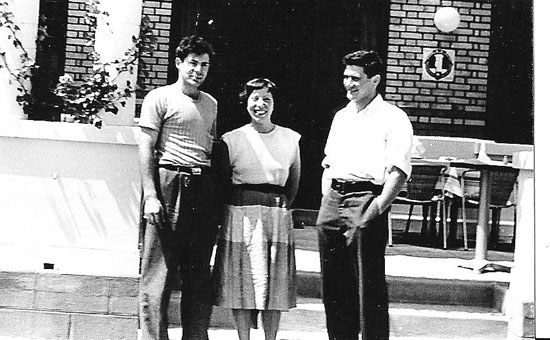 | | Morton C. Warnow on the right. "He was a brilliant, brilliant man," said Lafayette resident, Kimmen Sjölander, Ph.D., of her father, Morton C. Warnow. Photo provided by Kimmen Sjölander, Ph.D. | | | | | |






